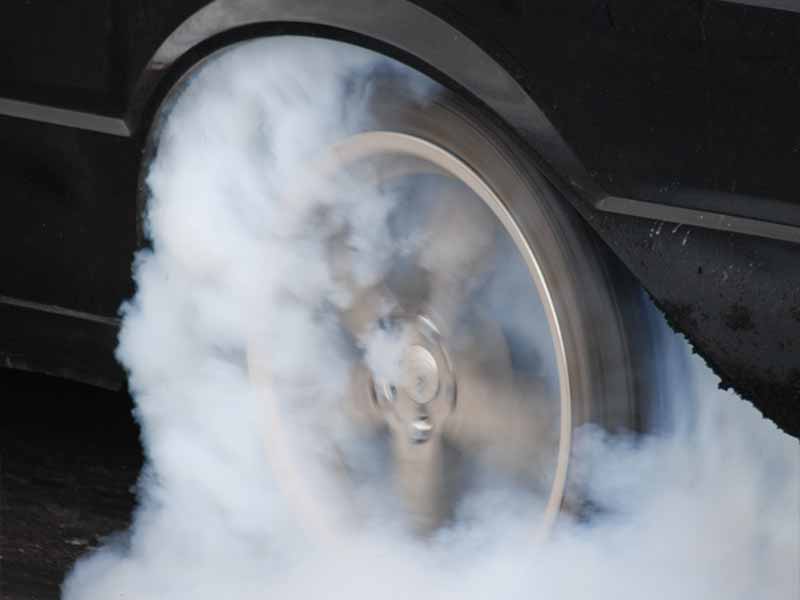One of the parts of a tire’s size is it’s speed rating. The speed rating will tell you its maximum speed capability. But this is only one aspect of how the speed rating system affects tire performance and handling characteristics.
Tire manufacturers test their tires to see the fastest speed they can withstand and safely sustain speeds shown in the tire speed rating charts. But why do they do this when the maximum speed numbers are so high?
It’s because these ratings are not just about speed.
What Is Speed Rating On Tires?
Tire speed rating is the tested top speed a tire is able to safely maintain without performance beginning to deteriorate due to the excess buildup of heat in the tire.
It is represented by a single letter (with the exception of “ZR”) at the end of the tire size code.
It’s unlikely your tires will ever need the maximum speed capability of their rating since they are usually well beyond the legal speed limits. But the performance improvements due to the improved heat resistance and sidewall reinforcement are key.
Let’s take a closer look
Where Is The Speed Rating On A Tire?
The speed rating of a tire is usually molded into the sidewall of a tire along with the tire size designation. It is usually the last metric displayed in the tire size sequence.
Tire speed ratings are paired with the load index. The load index is a 2 or 3 digit number followed by the letter designation of the speed rating.
Tire Speed Rating Chart
Speed ratings are indicated on your tire’s sidewall with a speed symbol as shown below. Each symbol represents a safe maximum sustainable speed.
| SPEED SYMBOL | MAX SAFE MPH |
|---|---|
| A1 | 3 |
| A2 | 6 |
| A3 | 9 |
| A4 | 12 |
| A5 | 16 |
| A6 | 19 |
| A7 | 22 |
| A8 | 25 |
| B | 31 |
| C | 37 |
| D | 40 |
| E | 43 |
| F | 50 |
| G | 56 |
| J | 62 |
| SPEED SYMBOL | MAX SAFE MPH |
|---|---|
| K | 68 |
| L | 75 |
| M | 81 |
| N | 87 |
| P | 93 |
| Q | 99 |
| R | 106 |
| S | 112 |
| T | 118 |
| U | 124 |
| H | 130 |
| V | 149 |
| W [Within ZR] | 168 |
| Y [Within ZR] | 186 |
| (Y) [Within ZR] | Above 186 |
ZR includes all tires with a rating above 149mph
Does Tire Speed Rating Matter?
Your tire’s speed rating is a guide to how much heat it is capable of handling at higher speeds. To handle the higher speeds a tire must use softer rubber compounds and stronger sidewall designs.
Generally speaking, a tire with a higher maximum speed capability will have better control and handling. It’s also common for tires capable of higher speeds to have worse ride comfort due to the stiffer sidewall designs.
What Is The Best Tire Speed Rating?
The best rating is the one that best fits the needs and meets or exceeds the manufacturer’s requirements.
Higher speed rated tires will have better control and handling as well as being able to handle speeds that you will likely never come close to seeing on public roads.
A higher speed rated tire will be able to handle higher speeds but it will usually have less tread life so simply going with higher speed ratings isn’t the best choice.
Usually following the vehicle owner’s manual tire specifications is recommended. The rating selected by the vehicle manufacturer will meet or exceed the requirements that most drivers of your vehicle type will need.

Does Higher Speed Rating Mean Better Tire?
Different speed ratings have different pros and cons. Higher speed ratings don’t necessarily mean a tire is better. The term “better” is a subjective term.
In general, while higher speed ratings will have better handling, steering response, and stopping power, it will have softer rubber compounds and wear out more quickly.
Lower speed rated tires are very capable for regular use on lower performance cars and will last much longer.
How To Choose Speed Rating On Tires
Vehicle manufacturers choose a tire’s speed rating based on the requirements of the car or truck and the recommended speeds the tire’s size code and tire’s performance requires.
You are best served by following the guidance of your vehicle manufacturer when you shop for new tires for your car or truck.
Can I Put A Higher Speed Rated Tire On My Car?
Purchasing tires with a higher speed rating than what is recommended by the manufacturer may not be money well spent. It depends on what characteristics you hope to improve by increasing the speed rating of the tires on your vehicle.
High performance sports cars may benefit from tires with a higher speed rating due to the improved performance characteristics of the tires.
A minivan on the other hand will likely not take advantage of the increased traction and handling nor appreciate the lower ride quality and faster tire wear.

Can I Put A Lower Speed Rated Tire On My Car?
It’s not recommended to purchase tires with a lower speed rating.
Changing to higher performance tires with a higher speed rating can be done safely, although with some compromises in comfort and tread wear.
Reducing the tire speed rating can reduce performance beyond that designed by the manufacturer of your car or truck. To safely maintain the performance level intended, you should always meet or exceed the tire specifications that your vehicle is intended to meet.
Can You Mix Tire Speed Ratings?
Never mix tire speed ratings. Having different ratings at different positions around your vehicle can create unbalanced and unpredictable handling characteristics.
Can I Use The Same Tire With A Different Speed Rating?
Tire manufacturers offer tire designs with different speed rating codes for the unique needs of various passenger cars and light trucks.
Purchasing four new tires with speed ratings greater than or equal to the recommended rating of the manufacturer is acceptable, but the speed ratings should never be lower than the rating on the tires the car or truck left the factory with.
Does Tire Speed Rating Affect Ride Quality?
In general, higher speed rated tires will have harsher ride characteristics due to the need to reinforce tire sidewalls to cope with excess heat from the increased speed capability.
To safely sustain speeds shown by the speed rating codes, rubber compounds become softer and sidewalls become more rigid.
Best Tire Speed Rating For Trucks And SUVs
Light trucks and large SUVs usually require lower speed rated tires such as N, P, Q, R, S, T, or H. It’s best to stick to the OEM tire size designation that includes the recommended speed rating.
Resources
Below are some links you may find helpful when learning about tires
- Tire speed rating and why it matters – Les Schwab
- Tire speed rating: What you need to know – Bridgestone
Final Thoughts
The ratings of tires for speed can be confusing. Especially when most of the speeds that tires are rated to safely maintain are so far beyond the legal speed limit.
These ratings are really less about speed and more about heat resistance, and in a sense, durability.
Our recommendation is to stick with the rating listing in the character sequence of the tire size designation. Performance vehicles can step up to a higher rating to improve handling and traction, but expect treadwear to be lower.
Good luck and happy motoring




